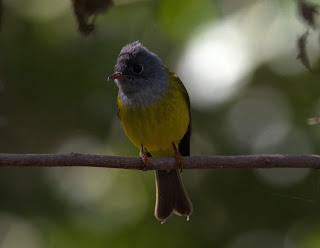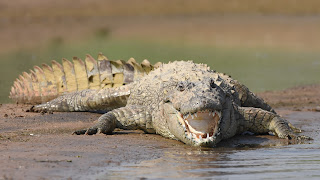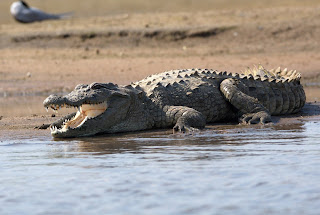Just returned from India – five days superb birding following a work trip. The work part was in Ahmedabad, Gujarat where I managed a half day at Thol Lake and the remaining time was spent in and around Bharatpur, Rajastan (Keoladeo National Park, Chambal River and Bund Baretha). Most of the birds I saw on most days but there were several species that really stood out. Orange-headed Thrush, Tickell’s Thrush, Small Minivet, Sulfur-bellied Warbler, Crested Serpent Eagle and Indian Scops Owls were personal favourites. Tickell’s Thrush in particular was a very tough bird but very rewarding when finally viewed well. ~164 species in total with the potential for many more.
I carried my bins
and camera everywhere and took advantage of coffee and lunch breaks
during work at PDPU, Ahmedabad to check out local birds.
Shikra,
Oriental White-eye,
White-bellied Drongo, Shikra,
Oriental White-eye,
Oriental Magpie Robin and the charismatic but ubiquitous Indian Robin,
Red-vented Bulbul
were easily seen in the well manicured campus. Here, too, I saw my first, wonderfully named, Rufous Treepie.
Thol Lake was a
shortish taxi ride from Ahmedabad. I choose this site above others
around the city as it seemed to hold a good variety of species and
was within easy reach of the city. In retrospect Indroda Nature Park
may have been a better choice for passerines but I also wanted to
escape the madding crowds and Thol Lake fitted that bill well. After
an unfortunate detour to Thol village the taxi driver dropped me off
at the park where a ‘guide’ attached himself to me. I really
cannot recommend these opportunistic guides. Laughing and
Red-collared Doves were Spotted Doves to him and an overhead Booted
Eagle was a Great Spotted Eagle (luckily he had a guide book and I
could show him the differences between the species). Oh well, he soon
tired of my contradictions and politely excused himself. When I was
able to finally concentrate on the birds I managed a fairly good
selection – 78 species in total including Bar-headed Geese,
Grey-headed Swamphens, White-cheeked Bulbuls
and Spot-billed ducks
galore. Painted Stork, Red-naped Ibis together with Glossy and Black-headed Ibises, Greater and Lesser Flamingo, Common and Saurus Cranes, huge numbers of duck but only a couple of River Tern were on the lake itself. The tree shaded walk around the lake provided several stunning birds – a bathing Shikra,
Sulfur-bellied Warbler,
a pair of gorgeously plumaged Small Minivets (female, male),
Bay-backed Shrike and Coppersmith Barbet. Pied, Yellow, Grey and Citrine Wagtails were all seen as well as Red-breasted Flycatcher,
Common Tailorbird, White-browed Fantail and Common Woodshrike. Several mystery warblers eluded me but I did manage one Hume’s Whitethroat in the low canopy – the chunky bill being very noticeable. After four hours of fun it became too hot for the passerines and too hazy for the waterbirds so I headed back to the city for a siesta.
After the meeting I
flew back to Delhi where a taxi was waiting for me for the 215 km
drive south to Bharatpur and four and a half days of birding. The
first three quarters and the last quarter of the trip took equal
amounts of time as we left the motorway and bumped our way through a
series of squalid, litter strewn and traffic-jammed villages. Very
relieved to finally check in to the Birder’s Inn. It was
mid-afternoon and although a cold beer was tempting the bird park was
more so. Crested Serpent Eagle, Dusky Eagle Owl,
Bronze-winged
Jacana (adult, juv), Indian Darter,
Long-tailed Shrike
and the famous Painted Storks
were my reward.
The next day was
full-on birding from 07:00 to about 18:00. I hired Satto Gurjar as a
guide. Contrary to Thol Lake, here guides are hugely important. They
know the good locations, the latest sightings and, importantly, the
calls. It was a really good day with highlights being Brown-headed Barbet
Hume’s
and Blythe’s Reed Warblers, Taiga Flycatcher, Grey Hornbill,
Great Coucal, Pied Bushchat (female, male), Grey-headed Canary Flycatcher,
The following day
was spent mostly at Chambal River, near Dholpur, a shortish taxi ride
south of Bharatpur. This river is one of the least polluted in India
and remains one of the last areas for critically endangered Gharials,
Mugger Crocodiles and Gangetic River Dolphins, all of which we were lucky enough to see. The bird specials were all found in the first half hour – Small Pratincole,
Indian Skimmer,
Black-bellied Tern,
River Tern, Great Thick-knee and River Lapwing. The latter two were on a small island just by the boating dock and the rest were on sand banks about five minutes upstream. Commoner birds such as White-browed Wagtails, Streak-breasted Swallows, Wire-tailed swallows and Bar-headed Geese also gave good views. Easy but rewarding birding. The next day had the toughest but possibly the best birding of the trip.
Satto had told me
that he knew where to find the much sought after Orange-headed and
Tickell’s Thrushes at Bund Baretha, fairly near Bharatpur.
Definitely couldn’t pass up an opportunity to try for those so we
met after breakfast, climbed into the waiting taxi and set off. I had
assumed we would travel straight to the site and was getting
increasingly frustrated by the apparently pointless detours we were
making. We stopped at yet another dusty and featureless patch of
field side and got out of the car. There in front of us was a small
flock of Ashy-crowned Sparrowlarks,
a Paddyfield Pipit and two Yellow-wattled Lapwings!
Decided not to doubt Satto’s abilities after that. A few km later we stopped by a house set in woodlands back from the road. The site was perfect for skulking thrushes – old stone walls, piles of leaves and brush, long untended vegetable patches and overgrown shrubs. A large colony of fruit bats created a racket above us with their calls. Satto and I started to work our way slowly through the area and before long I noticed a sudden movement in the leaf litter beneath a tree. In the dim light was a young Orange-headed Thrush tossing the litter for insects. Great views for a minute or so before it flitted off behind some decrepit outbuildings. This site also held Tickell’s Thrush but we had no luck despite a long and careful search. We decided to leave the site for a couple of hours and try another site by the lake. Walking through the sandy scrub (Large Grey Babbler,
Pied Bushchat, Long-tailed Shrike) towards the Bund Satto heard a high-pitched call – we turned towards it to see a stunning pair of Plum-headed Parakeets.
The lake beyond the Bund held flocks of distant water fowl including a small flock of Cotton Pygmy Geese but Satto’s attention was to a damp, wooded area on the outflow side of the dam. We worked our way slowly through the woods without success and were returning when an adult Orange-headed Thrush hopped onto the path, providing extended views. Wonderful!
Rain was falling when we returned to the first site and the gloom even thicker. We had been slowly working the area for a good 45 minutes when I noticed sudden movement in a berry filled bush and just about made out the dark blue shape of a male Tickell’s Thush. The view only lasted a couple of seconds and that was it. Despite extensive searching we couldn’t relocate it. Not disappointed though – both thrushes were at the top of my wish list.
On the way back (via
a long-billed Vulture site – several viewed on the cliff) Satto
promised another Tickell’s Thrush in Keoladeo itself. We met early
the following morning and detoured for tea near the gate. After
talking with some people at the tea shop Satto asked me if I wanted
to see Indian Scops Owls…. We entered a large garden area near to
the park and were soon looking up at a beautiful pair of roosting
owl
This is why the guides are important. There is absolutely no
way I would have seen them had I been by myself. With that wonderful
start to the day we entered the park and were soon (via Hume’s
Warblers, Ashy Drongos and Spotted Owlet) at the Tickell’s site.
Another Orange-headed Thrush made a brief appearance, a Blythe’s
Reed Warbler put on a great display, a Taiga Flycatcher kept calling and appearing briefly before flitting back into the undergrowth, then a brown thrush flew up into a tree. Female Tickell’s Thrush!
Over the next half hour we watched it feeding before it finally disappeared. The rest of the day was spent looking for warblers (Hume’s, Greenish, Siberian Chiffchaff) and revisiting the wetlands. Fly-by views of a Black Bittern, distant Dalmatian Pelicans, Pheasant-tailed Jacanas
and the only Woolly-necked Stork of the trip. Heavy clouds and not-so-distant thunder made us take a rickshaw back to the hotel and we arrived in torrential rain and hail. And that was it. Four and half days of excellent birding with many lifers. Keoladeo lives up to its name as a top birding spot.
Logistics
Costs in rupees
Taxis: Delhi IGI
Airport to Birder’s Inn (BI) – 5700 each way, BI to Dholpur
Chambal River – 3800, BI to Bund Baretha – 3000. Guides 250 per
hour or 2750 per day. Rickshaw 150 per hour (usually a two hour
minimum, plus tip).
Hotels: Starottel
(Ahmedabad) 3850 per night (very comfortable and well appointed
business hotel, great breakfasts and suppers). The Birder’s Inn
(Bharatpur) 3400 per night (clean and comfortable hotel, good
breakfast and buffet supper, very close to the park, helpful staff
will organise guides and taxis on request).
| Species name (Scientific name) | Status – seen most days unless stated otherwise |
| Grey francolin (Francolinus pondicerianus) | |
| Indian Peafowl (Pavo cristatus) | |
| Lesser Whistling-duck (Dendrocygna javanica) | |
| Greylag Goose (Anser anser) | |
| Bar-headed Goose (Anser indicus) | |
| Ruddy Shelduck (Tadorna ferruginea) | |
| Comb Duck (Sarkidiornis melanotos) | |
| Cotton Pygmy-goose (Nettapus coromunelianus) | 2, Keoladeo |
| Gadwall (Anas strepera) | |
| Eurasian Wigeon (Anas penelope) | |
| Mallard (Anas platyrhynchos) | |
| Spot-billed Duck (Anas poecilorhyncha) | |
| Northern Pintail (Anas acuta) | |
| Northern Shoveler (Anas clypeata) | |
| Garganey (Anas querquedula) | |
| Teal (Anas crecca) | |
| Red-crested Pochard (Netta rufina) | Bund Baretha |
| Pochard (Aythya ferina) | |
| Ferruginous Duck (Aythya nyroca) | |
| Yellow-crowned Woodpecker (Dendrocopos mahrattensis) | call, Keoladeo |
| Black-rumped Goldenback (Dinopium benghalense) | |
| Brown-headed Barbet (Megalaima zeylanica) | |
| Coppersmith Barbet (Megalaima haemacephala) | |
| Indian Grey-Hornbill (Ocyceros birostris) | |
| Eurasian Hoopoe (Upupa epops) | |
| Indian Roller (Coracias benghalensis) | |
| Kingfisher (Alcedo atthis) | |
| White-throated Kingfisher (Halcyon smyrnensis) | |
| Pied Kingfisher (Ceryle rudis) | |
| Little Green Bee-eater (Merops orientalis) | |
| Greater Coucal (Centropus sinensis) | |
| Rose-ringed Parakeet (Psittacula krameri) | |
| Plum-headed Parakeet (Psittacula cyanocephala) | 2, Bund Baretha |
| Little Swift (Apus affinis) | |
| Indian Scops Owl (Otus bakkamoena) | 2, near Keoladeo |
| Dusky Eagle-Owl (Bubo coromunus) | |
| Spotted Owlet (Athene brama) | |
| Rock Pigeon (Columba livia) | |
| Laughing Dove (Streptopelia senegalensis) | |
| Red-collared Dove (Streptopelia tranquebarica) | |
| Eurasian Collared Dove (Streptopelia decaocto) | |
| Yellow-footed Green-Pigeon (Treron phoenicoptera) | |
| Sarus Crane (Grus antigone) | |
| White-breasted Waterhen (Amaurornis phoenicurus) | |
| Purple Swamphen (Porphyrio porphyrio) | |
| Moorhen (Gallinula chloropus) | |
| Coot (Fulica atra) | |
| Black-tailed Godwit (Limosa limosa) | |
| Redshank (Tringa totanus) | |
| Marsh Sandpiper (Tringa stagnatilis) | |
| Greenshank (Tringa nebularia) | |
| Green Sandpiper (Tringa ochropus) | |
| Common Sandpiper (Actitis hypoleucos) | |
| Temmink's Stint (Calidris temminckii) | |
| Pheasant-tailed Jacana (Hydrophasianus chirurgus) | |
| Bronze-winged Jacana (Metopidius indicus) | |
| Eurasian Thick-knee (Burhinus oedicnemus) | |
| Great Thick-knee (Esacus recurvirostris) | Chambal River |
| Black-winged Stilt (Himantopus himantopus) | |
| Pied Avocet (Recurvirostra avosetta) | Thol Lake |
| Yellow-wattled Lapwing (Vanellus malabaricus) | near Bund Baretha |
| River Lapwing (Vanellus duvaucelii) | Chambal River |
| Red-wattled Lapwing (Vanellus indicus) | Chambal River |
| White-tailed Lapwing (Vanellus leucurus) | Keoladeo |
| Small Pratincole (Glareola lactea) | Chambal River |
| Indian Skimmer (Rynchops albicollis) | Chambal River |
| Great Black-headed or Pallas's Gull (Larus ichthyaetus) | Chambal River |
| River Tern (Sterna aurantia) | Chambal River |
| Black-bellied Tern (Sterna acuticauda) | Chambal River |
| Osprey (Pandion haliaetus) | |
| Black-winged Kite (Elanus caeruleus) | |
| Black Kite (Milvus migrans) | |
| Egyptian Vulture (Neophron percnopterus) | |
| Long-billed Vulture (Gyps indicus) | near Bund Baretha |
| Crested Serpent-Eagle (Spilornis cheela) | |
| Eurasian Marsh-Harrier (Circus aeruginosus) | |
| Shikra (Accipiter badius) | |
| Greater Spotted Eagle (Aquila clanga) | |
| Steppe Eagle (Aquila nipalensis) | |
| Imperial Eagle (Aquila heliaca) | |
| Booted Eagle (Hieraaetus pennatus) | |
| Kestrel (Falco tinunculus) | |
| Little Grebe (Tachybaptus ruficollis) | |
| Oriental darter (Anhinga melanogaster) | |
| Little Cormorant (Phalacrocorax niger) | |
| Indian cormorant (Phalacrocorax fuscicollis) | |
| Great cormorant (Phalacrocorax carbo) | |
| Little egret (Egretta garzetta) | |
| Grey Heron (Ardea cinerea) | |
| Purple heron (Ardea purpurea) | |
| Great egret (Casmerodius albus) | |
| Intermediate egret (Mesophoyx intermedia) | |
| Cattle egret (Bubulcus ibis) | |
| Indian pond heron (Ardeola grayii) | |
| Black-crowned Night-Heron (Nycticorax nycticorax) | |
| Black Bittern (Dupetor flavicollis) | 1, Keoladeo |
| Greater flamingo (Phoenicopterus ruber) | |
| Glossy Ibis (Plegadis falcinellus) | |
| Black-headed ibis (Threskiornis melanocephalus) | |
| Red-naped Ibis (Pseudibis papillosa) | Veda, Thol Lake |
| Eurasian Spoonbill (Platalea leucorodia Linnaeus) | |
| Great white pelican (Pelecanus onocrotalus) | |
| Dalmatian pelican (Pelecanus crispus) | |
| Painted Stork (Mycteria leucocephala) | |
| Wooly-necked Stork (Ciconia episcopus) | 1, Keoladeo |
| Black-necked Stork (Ephippiorhynchus asiaticus) | |
| Bay-backed Shrike (Lanius vittatus) | |
| Long-tailed Shrike (Lanius schach) | |
| Rufous Treepie (Dendrocitta vagabunda) | |
| House Crow (Corvus splendens) | |
| Large-billed Crow (Corvus macrorhynchos) | |
| Small Minivet (Pericrocotus cinnamomeus) | 2, Thol Lake |
| White-browed Fantail (Rhipidura aureola) | 2, Thol Lake |
| Black Drongo (Dicrurus macrocercus) | |
| Ashy Drongo (Dicrurus leucophaeus) | |
| White-bellied drongo (Dicrurus caerulescens) | 1, Ahmedabad |
| Common Woodshrike (Tephrodornis pondicerianus) | |
| Orange-headed Thrush (Zoothera citrina) | 2 at Bund Baretha and 1 at Keoladeo |
| Tickell's Thrush (Turdus unicolor) | 1 at Bund Baretha and 1 at Keoladeo |
| Red-breasted Flycatcher (Ficedula parva) | |
| Grey-headed Canary Flycatcher (Culicicapa ceylonensis) | |
| Bluethroat (Luscinia svecica) | |
| Oriental Magpie Robin (Copsychus saularis) | |
| Indian Robin (Saxicoloides fulicata) | |
| Black Redstart (Phoenicurus ochruros) | |
| Stonechat (Saxicola torquata) | |
| Pied Bushchat (Saxicola caprata) | |
| Brahminy Starling (Sturnus pagodarum) | |
| Rosy Starling (Sturnus roseus) | |
| Asian Pied Starling (Sturnus contra) | |
| Common Myna (Acridotheres tristis) | |
| Bank Myna (Acridotheres ginginianus) | |
| Dusky Crag-Martin (Hirundo concolor) | |
| Wire-tailed Swallow (Hirundo smithii) | |
| Streak-throated Swallow (Hirundo fluvicola) | Chambal River |
| White-eared Bulbul (Pycnonotus leucotis) | |
| Red-vented Bulbul (Pycnonotus cafer) | |
| Ashy Prinia (Prinia socialis) Graceful Prini (Prinia gracilis) |
|
| Plain Prinia (Prinia inornata) | |
| Oriental White-Eye (Zosterops palpebrosus) | 1, Ahmedabad |
| Blyth's Reed-Warbler (Acrocephalus dumetorum) | |
| Clamarous Reed-Warbler (Acrocephalus stentoreus) | |
| Common Tailorbird (Orthotomus sutorius) | |
| Chiffchaff (Phylloscopus collybita sp tristis) | |
| Sulphur-bellied Warbler (Phylloscopus griseolus) | 1, Thol Lake |
| Greenish Warbler (Phylloscopus trochiloides) | |
| Common Babbler (Turdoides caudatus) | |
| Large grey Babbler (Turdoides malcolmi) | |
| Jungle Babbler (Turdoides striatus) | |
| Lesser Whitethroat (Sylvia curruca) | |
| Hume’s Whitethroat (Sylvia altheae) | |
| Ashy-crowned Sparrow-Lark (Eremopterix grisea) | small flock near Bund Baretha |
| Crested Lark (Galerida cristata) | |
| Purple S bird (Nectarinia asiatica) | |
| House Sparrow (Passer domesticus) | |
| Chestnut-shouldered Petronia (Petronia xanthocollis) | |
| White Wagtail (Motacilla alba) | |
| White-browed Wagtail (Motacilla madaraspatensis) | Chambal River |
| Citrine Wagtail (Motacilla citreola) | 1, Thol Lake |
| Yellow Wagtail (Motacilla flava) | |
| Grey Wagtail (Motacilla cinerea) | |
| Paddyfield Pipit (Anthus rufulus) | near Bund Baretha |
| Indian Silverbill (Lonchura malabarica) |









































































































